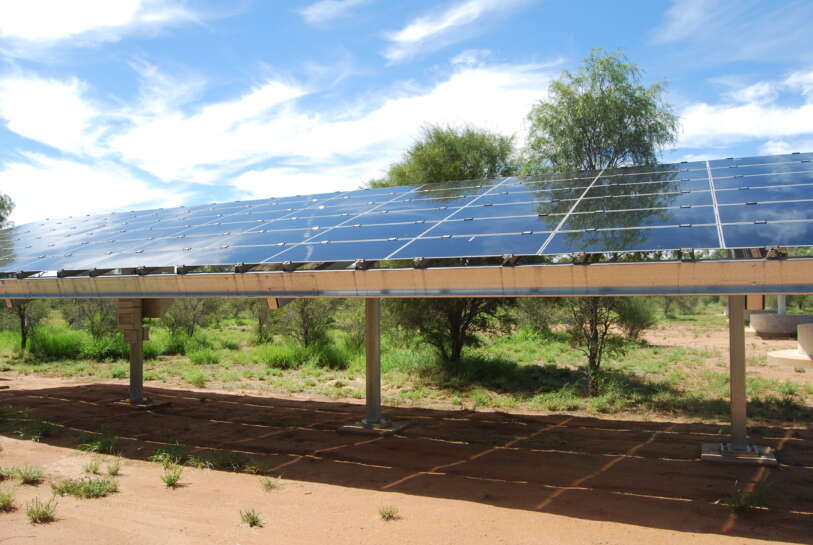| Manufacturer | Hanergy |
|---|---|
| Array Rating | 5.61kW |
| PV Technology | CIGS |
| Array Structure | Fixed: Ground Mount |
| Installed | 2010 |

Copper indium gallium di-selenide thin-film array, fixed ground-mount.
In this type of thin film module the active layer consists of Copper Indium Gallium di-Selinide (CIGS) instead of silicon. The long thin cells of CIGS modules make them less sensitive to partial shading compared to crystalline silicon modules.
In the laboratory, CIGS modules have achieved efficiencies comparable to crystalline silicon modules. Solibro CIGS modules have one of the highest conversion efficiencies of thin film modules produced on a commercial scale.
Solibro is a company of Hanergy. Hanergy is a global business that manufactures photovoltaic cells and modules.
The above technology description has been supplied by the manufacturer. The Desert Knowledge Australia Solar Centre is pleased to provide a platform for information sharing while not endorsing specific claims made about technologies installed at the site.
| Array Rating | 5.61kW |
|---|---|
| Number Of Panels | 66 |
| Panel Type | SL1-85 |
| Array Area | 49.48 m² |
| Type Of Tracker | N/A |
| Inverter Size / Type | 6kW, SMA SMC 6000A |
| Installation Completed | Sun, 1 Aug 2010 |
| Array Tilt/Azimuth | Tilt = 20, Azi = 0 (Solar North) |

Notes on the Data
-
System Disconnection for Cabling Works
All arrays at the Solar Centre were disconnected from approximately 2.00pm to 3.00pm on Monday, 9 July 2018 in preparation for the cable between the main switchboard and distribution board being upgraded. Array sites #23-38 remained disconnected while the main feeder cable to these sites was replaced in subsequent days, but all systems were re-connected by early afternoon on Thursday, 12 July 2018.
-
Site 27: Component Problems
Observations of the Site 27 modules made around late 2017/early 2018 have led to the removal of modules from the array for further study. In future months, the installation will be equipped with a newer module generation and remain offline until such time.
-
System Outage at Australia Day Long Weekend
A breaker tripped at around 12.30pm on Friday, 26 January, likely due to high generation levels reached at this peak time on this high irradiance day. Connection was restored after the Australia Day long weekend at around 11.30am on Monday, 29 January but shortly tripped again.
UPDATE 26-02-2018. The cause of this reoccurring issue has been identified and will be rectified. The solution requires the upgrading of a key distribution cable. This should be completed in the coming months.
-
Connection Restored After Christmas/NY Period
Arrays have been re-connected following the outage that disconnected multiple sites from Christmas day 2017. The outage is believed to have been triggered by the tripping of two circuit breakers in separate distribution boards, making the diagnosis initially elusive. The ability of the common circuit shared by these arrays to keep abreast with increasingly high current demands as new arrays are installed and generation conditions are high is presently being addressed. For the same reason, intermittent outages persisted in the summer of early 2018.
-
System Outage at Christmas/NY Period
A system outage was caused by a circuit breaker trip at approximately 2pm on a high generation day shortly after installation of a new array at the DKA Solar Centre. The outage commenced on 25 December continuing into the new year and is being addressed.
-
System Outage for New Array Connection
Sites 23 through to 37 experienced an outage today from 11:10 to 11:50. The outage was due to the local distribution board being temporarily being taken offline to allow for the connection of a new PV system.
-
Site 27: Spotted Module Replacement
Three of the modules showing signs of sun spot damage on their surfaces have been replaced, as well as one of the adjacent modules which was accidentally affected during the replacement process. These works required system outages at 4-5pm on Monday, 2 October and 10-11am on Tuesday, 3 October.
-
Monitoring Interruption for UPS Battery Replacement
The disconnection and re-connection of the solar arrays and weather station equipment while a new site connection was being established prompted the already flattening UPS batteries which power the site’s energy meters to fail and require immediate replacement. Data recording was affected from approximately 2.30pm ACST, Monday 10 July to 4.00pm, Wednesday 12 July.
Affects weather data for DKASC, Alice Springs
-
Partial System Outage
One of the major switchboards at the DKASC lost power yesterday 01/12/2016 at ~11:00 am. This isolated and shutdown array sites 23 through to 37 inclusive. The switchboard was re-energised at ~16:30 today (02/12/2016) and is again operating normally. Data for this period for these sites is lost.
-
Sites 24 and 27: Temporary Outage
Both Site 24 and 27 went offline from the 14th to the 17th November 2016. This outage was caused by a contractor working on another system turning off these two systems for safety reasons and then forgetting to turn them back on after the work was complete. This outage was not a fault of the technology itself but rather simple human error.
> Answer to Spotlight Question
Onsite at the DKA Solar Centre in Alice Springs are a series of quiz-like Spotlight Questions at each array. Visit the centre and scan the QR code at each sign to test your knowledge – and check your answer here!
Q: What other chemistries are used for thin film modules? (Hint: Check out arrays #7 and #8!)
A: The photovoltaic layer of a thin film solar module may be made of various chemistries, the most common being amorphous silicon (a-Si), cadmium telluride (CdTe) and CIGS (cadmium indium (di)selenide) or its variant CIS (cadmium indium selenide).
